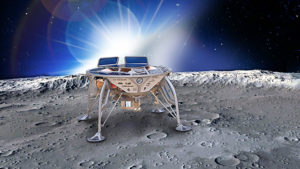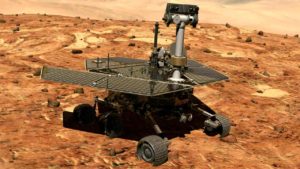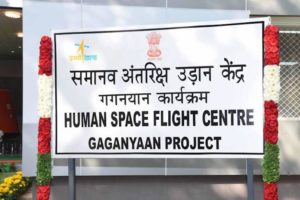 Israel is to launch its first moon mission, sending an unmanned spacecraft to collect data to be shared with NASA. According to a report, the 585-kilogram Beresheet (Genesis)spacecraft is to lift off atop a Falcon 9 rocket from Cape Canaveral, Florida. Mission control will be in Yehud, near Tel Aviv. Israel is to launch its first moon mission, sending an unmanned spacecraft to collect data to be shared with NASA. According to a report, the 585-kilogram Beresheet (Genesis)spacecraft is to lift off atop a Falcon 9 rocket from Cape Canaveral, Florida. Mission control will be in Yehud, near Tel Aviv. |
| Source: News On AIR |
 AntBot is the first walking robot to have navigational capabilities without GPS or mapping. It has been designed by Centre for Scientific Research (CNRS) and Aix-Marseille University researchers at ISM, on lines similar to desert ants who use polarised lights and UV radiation to navigate in space. It consists of an optical compass which determines its movements by the help of polarised light. Weighing only 2.3 kg, this robot has six feet for increased mobility, allowing it to move in complex environments, precisely where deploying wheeled robots and drones can be complicated. AntBot is the first walking robot to have navigational capabilities without GPS or mapping. It has been designed by Centre for Scientific Research (CNRS) and Aix-Marseille University researchers at ISM, on lines similar to desert ants who use polarised lights and UV radiation to navigate in space. It consists of an optical compass which determines its movements by the help of polarised light. Weighing only 2.3 kg, this robot has six feet for increased mobility, allowing it to move in complex environments, precisely where deploying wheeled robots and drones can be complicated. |
| Source: Indian Express |
 Infosys, the country’s 2nd largest IT firm has launched a next-generation digital platform ‘InfyTQ’ to facilitate engineering students with best learning experiences by imparting technical and professional skills. InfyTQ is a free platform available on both mobile and desktop, featured with always-on, anytime, anywhere learning catered through a continuous transfer of digital skills. Infosys, the country’s 2nd largest IT firm has launched a next-generation digital platform ‘InfyTQ’ to facilitate engineering students with best learning experiences by imparting technical and professional skills. InfyTQ is a free platform available on both mobile and desktop, featured with always-on, anytime, anywhere learning catered through a continuous transfer of digital skills. |
| Source: Infosys |
 NASA has announced a new space telescope mission dedicated to understanding the origins of life and the universe. It’s called the Spectro-Photometer for the History of the Universe, Epoch of Reionization and Ices Explorer or SPHEREx, for short. The space agency is aiming for a 2023 launch. Once SPHEREx is in orbit, it will observe and collect data on over 300 million galaxies, some as far as 10 billion light-years away from Earth, and 100 million stars in our own Milky Way every six months. The space telescope’s main goals, though, are to search for water and organic molecules within the Milky Way. It will also look for those ingredients of life in regions where stars are born. NASA has announced a new space telescope mission dedicated to understanding the origins of life and the universe. It’s called the Spectro-Photometer for the History of the Universe, Epoch of Reionization and Ices Explorer or SPHEREx, for short. The space agency is aiming for a 2023 launch. Once SPHEREx is in orbit, it will observe and collect data on over 300 million galaxies, some as far as 10 billion light-years away from Earth, and 100 million stars in our own Milky Way every six months. The space telescope’s main goals, though, are to search for water and organic molecules within the Milky Way. It will also look for those ingredients of life in regions where stars are born. |
| Source: Space.com |
 NASA announced that its Opportunity Rover mission is complete after the rover failed to respond despite repeated trials since August 2018. The space agency inferred that a planet-encircling dust storm cut off communications with Opportunity on June 10, 2018, disabling its solar panels from storing power. Since then NASA has beamed over 830 unanswered rescue commands. The robotic rover, which wandered the surface of the red planet for over 15 years, was launched by NASA in July 2003 as a part of its Mars Exploration Rover program. It is survived by NASA’s Curiosity rover, which is now the only active robot on Mars. NASA announced that its Opportunity Rover mission is complete after the rover failed to respond despite repeated trials since August 2018. The space agency inferred that a planet-encircling dust storm cut off communications with Opportunity on June 10, 2018, disabling its solar panels from storing power. Since then NASA has beamed over 830 unanswered rescue commands. The robotic rover, which wandered the surface of the red planet for over 15 years, was launched by NASA in July 2003 as a part of its Mars Exploration Rover program. It is survived by NASA’s Curiosity rover, which is now the only active robot on Mars. |
| Source: The Money Control |
 India’s 40th communication satellite GSAT-31 has been launched successfully from French Guiana. The Ariane-5 rocket lifted off with it from Kourou Launch Base, and in 42-minutes, placed it in the intended Geosynchronous Transfer Orbit. It was immediately taken control by Indian Space Research Organization ISRO scientists from its Hassan facility in Karnataka. GSAT-31 will provide transponder capacity for DTH television and connectivity to services like VSATs for ATMs, stock-exchanges, Digital Satellite News Gathering DSNG and e-governance applications. India’s 40th communication satellite GSAT-31 has been launched successfully from French Guiana. The Ariane-5 rocket lifted off with it from Kourou Launch Base, and in 42-minutes, placed it in the intended Geosynchronous Transfer Orbit. It was immediately taken control by Indian Space Research Organization ISRO scientists from its Hassan facility in Karnataka. GSAT-31 will provide transponder capacity for DTH television and connectivity to services like VSATs for ATMs, stock-exchanges, Digital Satellite News Gathering DSNG and e-governance applications. |
|
About GSAT-31 in Brief:
|
| Source- Press Information Bureau (PIB) |
 The Indian Space Research Organisation (ISRO) unveiled its Human Space Flight Centre (HSFC) at ISRO Headquarter campus in Bengaluru, Karnataka for its maiden manned space mission ‘Gaganyaan’. The space flight centre was inaugurated by K Kasturirangan, former ISRO Chairman. ISRO is gearing up for its maiden manned mission Gaganyaan, which is planned for 2021-end. The plan is to have the first unmanned mission in December 2020 and the second one in July 2021. Once the two unmanned missions are completed, the manned mission will happen in December 2021. The Indian Space Research Organisation (ISRO) unveiled its Human Space Flight Centre (HSFC) at ISRO Headquarter campus in Bengaluru, Karnataka for its maiden manned space mission ‘Gaganyaan’. The space flight centre was inaugurated by K Kasturirangan, former ISRO Chairman. ISRO is gearing up for its maiden manned mission Gaganyaan, which is planned for 2021-end. The plan is to have the first unmanned mission in December 2020 and the second one in July 2021. Once the two unmanned missions are completed, the manned mission will happen in December 2021. |
| Source- The Economic Times |
 The Defence Research and Development Organisation (DRDO) has successfully test fired Long Range Surface to Air Missile (LR-SAM) from naval warship INS Chennai.The test was conducted off the coast of Odisha. The LR-SAM hit a low flying aerial target during the test. The Defence Research and Development Organisation (DRDO) has successfully test fired Long Range Surface to Air Missile (LR-SAM) from naval warship INS Chennai.The test was conducted off the coast of Odisha. The LR-SAM hit a low flying aerial target during the test. |
| Source- Press Information Bureau (PIB) |
 The Indian Space Research Organisation successfully launched the PSLV C 44 carrying Kalam sat and imaging satellite Microsat R. The rocket precisely injected the Microsat R in its designated orbit. The satellite was launched from the Sathish Dhawan Space Centre Sriharikota, Andhra Pradesh. The Indian Space Research Organisation successfully launched the PSLV C 44 carrying Kalam sat and imaging satellite Microsat R. The rocket precisely injected the Microsat R in its designated orbit. The satellite was launched from the Sathish Dhawan Space Centre Sriharikota, Andhra Pradesh. |
 |
| Kalamsat is a ten cm cube weighing one-kilogram communication satellite with a life span of two months. With this launch, India becomes the first country to use the fourth stage of a space rocket as an orbital platform for microgravity experiments. |
| Source- ISRO |
 Social media giant Facebook announced that it will create an independent Institute for Ethics in Artificial intelligence (AI) with an initial investment of $7.5 million over a period of five years. Technical University of Munich (TUM) in Germany will collaborate with this project which aims to explore fundamental issues affecting the use and impact of AI. The Institute will address issues that affecting the use and impact of AI such as Safety, Privacy, Fairness, and transparency. TUM was ranked 6th in the world for AI research by the Times Higher Education magazine in 2018. Social media giant Facebook announced that it will create an independent Institute for Ethics in Artificial intelligence (AI) with an initial investment of $7.5 million over a period of five years. Technical University of Munich (TUM) in Germany will collaborate with this project which aims to explore fundamental issues affecting the use and impact of AI. The Institute will address issues that affecting the use and impact of AI such as Safety, Privacy, Fairness, and transparency. TUM was ranked 6th in the world for AI research by the Times Higher Education magazine in 2018. |
| Source: Forbes |
You need to login to perform this action.
You will be redirected in
3 sec
